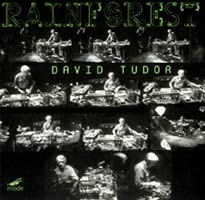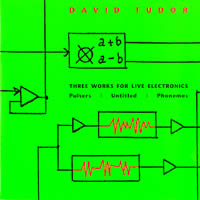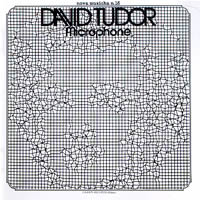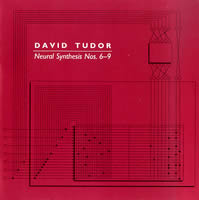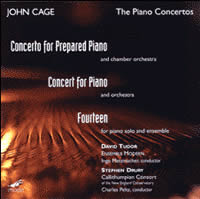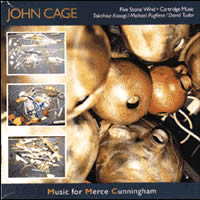David Tudor: Performer and Composer of Live Electronic Music
|
Grant Chu Covell [April 2003.] One of the 20th century’s pivotal musicians, David Tudor, whom we normally think of as a rather amazing pianist, is less often identified as a composer and performer of live electronic music, regrettably so. However, in the coming years, I expect that Tudor’s keyboard prowess will succumb to his reputation and influence as a composer. Tudor worked with analog circuitry, and his proficiency therein is astonishing. Ours is a digital world in which most of Tudor’s equipment is looked upon as obsolete, having fallen off the back pages of hobbyist magazines years ago. It is seen, if at all, as the detritus of museum exhibits, or worse yet, as junk. A listener unused to the coarseness and bite of analog electronic and computer music will find Tudor’s compositions invigorating. If you have ever tried to pull in a distant AM radio station only to be thrilled by the strange, extraneous noises that came and fled, Tudor’s electronic music is most assuredly for you. I don’t want to diminish Tudor’s primary reputation. He was the preferred pianist-interpreter / -collaborator / -tour guide in the post-serial wanderings of avant-garde American and European composers. Tudor gave the premieres and definitive performances of many important mid-century works: Pierre Boulez’s Second Piano Sonata (1947/48), John Cage’s Music of Changes (1951), and several of Karlheinz Stockhausen’s Klavierstücke. Some composers wrote explicitly for him, implying that a performance’s success relied as often as not on Tudor’s ability to realize indeterminate and graphic compositions, e.g., Sylvano Bussotti’s Five Piano Pieces for David Tudor (1959) and Richard Maxfield’s Piano Concert for David Tudor (1961). Representative recordings of Tudor at the keyboard include Piano Avant-Garde (hatART CD 6181), with tapings made between 1956 and ’60 of music by Cage, Cornelius Cardew, Henri Pousseur, Christian Wolff, and others. CRI CD 620 features delicate performances of the first three parts of Morton Feldman’s The Viola in My Life (on the same disc Feldman plays the piano in Why Patterns?). Recorded between 1958-9, Tudor plays the abovementioned Klavierstücke on hatART CD 6142. New World Records NW 80555 offers Maxfield’s Piano Concert for David Tudor. For the true enthusiast, Tudor and Cage navigate the 1954 premiere of Cage’s 12’55.6078″ for two pianists (prepared piano), accompanied by heckling, laughing, and interruptions on the 12-disc 75 Jahre Donaueschinger Musiktage: 1921-1996 (col legno WWE 31899). Tudor was born in Philadelphia, Pennsylvania, on January 20, 1926. He studied organ and music theory with H. William Hawke, piano with Irma Wolpe Rademacher, and composition with Stephan Wolpe. It was with the American premiere of Boulez’s Second Piano Sonata on December 17, 1950 that Tudor firmly established himself as a leading new-music proponent. His long-term collaboration with Cage began in the 1950’s (it was Cage who gave Tudor the Boulez Sonata). Both men were closely connected with the Merce Cunningham Dance Company from its start in ’53. In the late 1950’s, Tudor began using electronics during his piano performances. By the late 60’s, he had turned away from the piano almost entirely to work with electronics, performing at the keyboard for special projects and recordings only (one such recording is Cage’s Atlas Ecliptalis and Winter Music on Asphodel ASPH 2000). When Cage died in ’92, Tudor succeeded him as the Merce Cunningham Dance Company’s Musical Director. Tudor died in Tomkins Cove, New York, on August 13, 1996. Tudor credits Cage, Toshi Ichiyanagi, and Gordon Mumma with spurring his interest in composition, specifically electronic composition. What appealed to Tudor is the inherent frailty of live electronics: Performances were about finding the right balance between order and chaos. Rather than silence or deafening noise, he sought sounds just beyond the reach of control. In Microphone (1973), for example, he intentionally positioned microphones and loudspeakers to create feedback. Tudor’s work with electronics was often about pushing an electronic component to its extremes, or prodding a setup to its full potential. Breakthroughs would occur at the point where the equipment ventured beyond its presumed limits. Understandably, most of Tudor’s electronics were homemade. He sometimes used soap dishes to house his circuits, never troubling to label his creations’ controls, inputs or outputs! Looking back over his career, Tudor considered his first composition to be Fluorescent Sound of 1964. It was performed on September 13 at a Stockholm museum as accompaniment to a dance collaboration between Robert Rauschenberg and Steve Paxton. Rauschenberg called his part of the evening “Elgin Tie,” its most memorable moment, Rauschenberg walking a cow around the inside of the museum. For this work, Tudor amplified the hum and flicker of 200 of the museum’s ceiling lights. Tudor conceived most of his music as accompaniments to visual arts such as dance, lighting, theater or film.
I could start and end my recommendations with Rainforest I (1968), a groundbreaking phenomenon like nothing else before or since. Written for the Merce Cunningham Dance Company, Rainforest I is captured in a 1990 live performance by Tudor and Takehisa Kosugi on mode 64. Rainforest I is on my list of the best electroacoustic works of all time, and if at the end of this article you have but the slightest interest in Tudor, you must hear this CD. You actually should stop reading now, head on over to http://www.mode.com/ and order it. You probably have an idea of what a rain forest sounds like, thanks to tourism, nature TV and movies. Rainforest I is bound to disrupt all that. Rather than field-recording a rainforest, Tudor created an electronic fantasy absent ambient nature samples and similar clichés. Rainforest I consists of complex, homemade electronic circuitry manipulated in real time by Tudor and Kosugi to create something alien yet curiously organic. You will hear itchy-crawly electronic circuits pulsing, whirring and chirping. I’ve been to Costa Rica and experienced the real thing: Nothing in nature sounds anything like this. Mode 64 also includes another electroacoustic environment, Rainforest IV (1973). Some of the musicians who worked with Tudor on Rainforest IV believe that this recording doesn’t do the work justice; nonetheless, you must snap up this mode CD.
David Tudor: Three Works for Live Electronics (Lovely Music LCD 1601) reissues LP versions of Untitled (1972) and Pulsers (1976), and adds Phonemes (1981) as a bonus (Lovely Music is at http://www.lovely.com/ and their CDs can be found at Forced Exposure (http://www.forcedexposure.com/). Untitled offers vocalizations by Kosugi over a rich tapestry of electronic whirls and crackles. Written to accompany Cage’s readings of Mesostics re Merce Cunningham (1971), this work is similar to the sound world of Rainforest I. Pulsers is a study on rhythms created by analog electronic circuitry. In this rapidly changing 20-minute work, Tudor modified a complex modulator circuit originally developed by Gordon Mumma. The analog circuit creates bracing bubbling noises in a fast rhythm. A little before the 7:30 point, the pure electronic sounds are interwoven with Kosugi improvising on electric violin. I enjoy the monolithic quality of the purely electronic sounds but could do without the violin. Phonemes is also packed with a variety of the snap, crackle and pop noises we associate with electronic music: corny in an endearing sort of way. When my older son was a year-and-a-half, he heard the opening of this work (a slow upwards glissando), giggled, and exclaimed, “Noise!” Of course he’s used to hearing Lachenmann and Xenakis around the house, too.
Microphone (1973), while necessary for the collector who must have everything, is a hard sell to the mainstream listener. Basically, this piece consists of tightly controlled bursts of microphone feedback in an echo chamber, sounding much like huge and unhappy electronic beasts. Taped at Mills College, Oakland, CA, we have two versions of this work on the tough-to-find Cramps CD (CRSCD 116). The notes, in Italian, include pictures of Tudor at the controls and a diagram of the electronic circuits. I find this one more appealing each time I listen to it. The different versions reflect different combinations of the nine master tapes that Tudor used as sources. Here and there you will find excerpts of larger works. A snippet from a 1988 performance of Webwork (1987) is on the awkward but well-intentioned A Chance Operation: The John Cage Tribute (Koch 3-7238-2). Akin to Pulsers, this piece uses circuitry to create rich burblings and splutterings that pass by one after the other. The theme seems to be liquids, as some of the sounds suggest the hiss of escaping steam or that amusingly impolite sound of slurping the last of a drink with a straw. I’d like to hear more of this piece but can’t recommend this two-CD set just for this composition despite its impressive roster of composers and performers. An excerpt from Dialects (1984) appears on Imaginary Landscapes (Nonesuch 79235), an uneven compilation of electronic music emphasizing synthesizers and real-time performance.
Neural Synthesis Nos. 6–9 (1992) on Lovely Music LCD 1602 are 1994 recordings of work first performed in 1992 for Merce Cunningham. At first, Neural Synthesis sounds like a sparse combination of all the other works I’ve mentioned, but the types of sounds are much richer and they’re presented with greater contrasts in activity, dynamics, and spatialization. At their core is a neural-network chip that emulates the neuron cells in our brains. It’s combined with a synthesizer and other electronic circuitry. Key to the multiple versions of what are essentially the same pieces (or setups) are stereophonic and binaural methodologies, the latter designed for headphones, the intended medium for listening to these absorbing works. It’s impossible to talk of Tudor without mentioning his collaboration with Cage, a partnership that has effectively diminished Tudor’s position as composer. Given their personalities (Cage was famously gregarious, Tudor was markedly reticent), Tudor has been unfairly cast as Cage’s sidekick. He was anything but: His use of live electronics was nothing short of brilliant as an impressive body of work attests. He introduced Cage to a territory Cage might never have found for himself. A survey of some key Cage / Tudor collaborations and obtainable recordings is necessary to complete our picture of Tudor as composer. Even though Tudor in this instance is not working with electronics, a discussion of the Cage / Tudor collaboration is incomplete without mention of the 1959 classic Indeterminacy, “New Aspect of Form in Instrumental and Electronic Music: Ninety Stories by John Cage, with Music” (Smithsonian Folkways SF 40804/5). In Indeterminacy, Cage reads while Tudor makes sounds. The notes detail how it took the bemused sound engineer some time to understand that Cage was going to read stories in one room while Tudor would sample recordings of Cage’s Concert for Piano and Orchestra (1957-58) and Fontana Mix (1958) in another, each man unaware of what the other was doing.
There are two available recordings of Tudor playing the solo part of Cage’s Concert for Piano and Orchestra, one of Cage’s most appealing indeterminate works. The performers construct their parts from material that Cage provides, and the piano soloist gets 63 large pages from which to create a part. Tudor uses both piano and live electronics with the Ensemble Modern under Ingo Metzmacher on a 1992 recording, John Cage: The Piano Concertos (mode 57). On the remainder of this marvelous mode disc Stephen Drury and the Callithumpian Consort explore Cage’s Concerto for Prepared Piano and Orchestra (1951) and Fourteen (1990), one of the late number pieces. Tudor does not use electronics in the 1958 recording of the Concert on the 3-CD set entitled The 25-Year Retrospective Concert of the Music of John Cage (Wergo 6247-2). Indeterminacy is successful because Cage’s stories are amusing and Tudor’s sound sources so rich and varied. At the other extreme is the 1972 simultaneous recording of Cage reading Mureau with Tudor performing Rainforest II (New World Records 80540-2, two CDs). Mureau is one of Cage’s elaborate celebrations of Henry David Thoreau in which he mashes phrases and syllables from Thoreau’s journals. Rainforest II is similar to Tudor’s other works in the series in that it takes the voice as its source sound rather than pure electronic signals. The combination is like a Noh play or similar non-Western ritual on the verge of going bad. Cage’s reading is nigh to unintelligible and rather creepy-sounding, which might be fine on its own, but with Tudor’s gritty and uncompromising electronic sounds, it’s a tough sit though both CDs (43:02 + 51:17).
Mode comes through with another important disc capturing Tudor at work with live electronics. Music for Merce Cunningham (mode 24) has Cage’s Cartridge Music (1960) and Five Stone Wind (1988). Taken purely as examples of Cage’s chance-based compositions, these pieces are quaint, perhaps even a bit tedious. But when the focus is on what Tudor is doing, this music becomes compelling. Recorded in 1989, Five Stone Wind commands 55 minutes of one’s time. Quiet and delicate, we hear bamboo flute, amplified violin (Kosugi yet again), and clay pots played by percussionist Michael Pugliese. Tudor and Kosugi, handling live electronics at the center of it all, extract immense variety from remarkably few sounds. The similarity to Pulsers and Untitled from years before is evident enough, yet Tudor’s sounds are sparser and much more delicate here. This disc is filled out with a 1988 performance of Tudor’s realization of Cage’s Cartridge Music, a work that puts odd items (pins, Slinkys, pipe-cleaners, matches, etc.) into phonograph cartridges, amplifying these and other “small objects.” Without knowing what’s going on or anything about Cage and Tudor, you might think these are the sounds of people trying to break out of a cell with plastic forks. Cage fans probably don’t realize how important Tudor is to these two pieces. As with the mode disc of Cage’s Piano Concertos (mode 57), here is another rare and priceless opportunity to hear an amplified Slinky. Most of Tudor’s compositions required him to be a part of the performance, leading to understandable concerns about his music’s viability after his death. Similar concerns occur with the late compositions of Luigi Nono mixing live electronics with instruments, e.g., Guai ai gelidi mostri (1983), A Pierre. Dell’azzurro silenzio, inquietum (1985), and Post-prae-ludium n. 1 “per Donau” (1987). Both composers collaborated with a small circle of dedicated performers and technicians who applied their knowing expertise to vague written instructions and diagrams. Nono frequently adjusted his music for different performance venues, and a work would often go through several performances before it was deemed finished. In 1973, with John Driscoll, Ralph Jones, and Martin Kalve, Tudor founded Composers Inside Electronics, committed to creating and performing live electronic music. The intention was to build a community where techniques and instruments could be shared, as well as to perform live electronic works by group members. Tudor’s Rainforest IV was one of Composers Inside Electronics’ first productions. Additional members of the group since its founding include Linda Fisher, Bill Viola, Phil Edelstein, John D.S. Adams, and D’Arcy Philip Gray. Articles on Tudor and his work have appeared in the magazine Musicworks, http://www.musicworks.ca/. Several articles on Tudor are planned for a future issue of the Leonardo Music Journal, http://mitpress2.mit.edu/e-journals/Leonardo/home.html. A Tudor Website is maintained by the Electronic Music Foundation, http://www.emf.org/tudor/index.html. The Getty Research Institute, http://www.getty.edu/research/tools/digital/davidtudor/, possesses all of Tudor’s papers. To say it again, if you want to hear Tudor at his best as composer and performer of live electronic music, acquire Rainforest I on mode 64. Three Works for Live Electronics on Lovely (LCD 1601) would be my second choice, and after that, Microphone on Cramps (CRSCD 116). To further fill the shelves, go for mode 24 with John Cage’s Five Stone Wind, the Neural Synthesis set on Lovely LCD 1602, and mode 57, with Cage’s Piano Concertos, in any order of preference. Indeterminacy (Smithsonian Folkways SF 40804/5) is also something to consider having. Tudor frolicked between welcome and discomfort, keeping chaos at arm’s length by the merest flick of a dial. His influence, while limited, is most assuredly significant. A time will come when folks aware of Tudor’s music will be surprised to learn that he once played the piano. [The Cramps CD may be hard, indeed impossible, to find. Try Verge Music (http://www.vergemusic.com/) where it’s listed. Forced Exposure (http://www.forcedexposure.com/) offers the program as a newly issued LP (!), Get Back (GET 417). Ed.]
[More Grant Chu Covell]
[Previous Article:
Mahler on the Radio]
[Next Article:
Things That Are Not Quite What They Seem]
|
